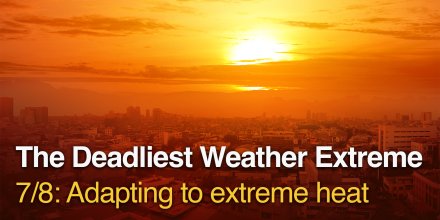
Webinar: Climate Data Tools for Resilient Urban Planning
This second webinar in the series presents digital tools that turn climate data into actionable strategies for urban resilience.


This second webinar in the series presents digital tools that turn climate data into actionable strategies for urban resilience.

Rising heat risks demand better planning, stronger warning systems, and targeted adaptation strategies.
|
|
|||||||||
|---|---|---|---|---|---|---|---|---|---|
|
Icon
|

|

|

|

|

|

|

|

|
|
|
Temperature (°F)
|
|||||||||
|
Temperature felt (°F)
|
27° |
25° |
22° |
22° |
24° |
23° |
24° |
24° |
|
|
Wind direction
|
WSW |
SW |
SW |
SW |
SSW |
SW |
SW |
SW |
|
|
Wind speed (mph)
|
WSW
13-30
13-30
|
SW
14-33
14-33
|
SW
21-48
21-48
|
SW
21-41
21-41
|
SSW
18-34
18-34
|
SW
14-35
14-35
|
SW
12-30
12-30
|
SW
12-30
12-30
|
|
|
Precipitation (in/3h)
|
0.05 in
100%
0.05
|
0.07 in
100%
0.07
|
0.12 in
100%
0.12
|
0.17 in
100%
0.17
|
0.08 in
100%
0.08
|
< 0.04 in
70%
< 0.04
|
< 0.04 in
85%
< 0.04
|
< 0.04 in
80%
< 0.04
|
|
|
Precipitation probability
|
100%
|
100%
|
100%
|
100%
|
100%
|
70%
|
85%
|
80%
|
|
|
Precipitation hourly
|
|||||||||
|
rainSPOT
Precipitation distribution within 20 km
|
|
The whole day it is cloudy with a wintry mix of snow and rain. The sun will not be visible. A very high chance of Precipitation near 90% is forecast. Temperatures peaking at 40 °F. Overnight into Tuesday expect a moderate breeze (12 to 18 mph). During the day blows a fresh breeze (18 to 25 mph). Gusts to 49 mph are possible. Winds blowing from Southwest. The weather forecast for Mt Lyford for Tuesday is likely to be accurate.
Pressure: 1011 hPa
Timezone: NZST (UTC +12:00h)
High wind speeds expected for Mt Lyford. More Weather Maps
The animation shows the wind conditions of the storm at 200m above ground, which corresponds well with expected gusts at the surface. Choose other time steps to see the forecast of the storm.
The location marker is placed on Mt Lyford. Orange crosses indicate lightning. Data provided by nowcast.de (available in USA, Europe, Australia). Drizzle or light snow fall might be invisible for the radar. Precipitation intensity is colour coded, ranging from turquoise to red.
The real-time satellite image combines visible light during daytime with infrared radiation during nighttime. At night, the image is not dark as infrared radiation can detect temperature differences. Unfortunately, low clouds and fog are difficult to distinguish from ground temperatures and thus can be almost invisible during the night. Meteosat satellite images for Europe are updated in real-time every 5 minutes. GOES-16/GOES-17 (North & South America) and Himawari (Asia) images update every 10 minutes.
Precipitation is estimated from radar and satellites. Precipitation estimates from satellites are less accurate at night than during daytime.
© 2025 meteoblue, NOAA Satellites GOES-16 and EUMETSAT. Lightning data provided by nowcast.

This second webinar in the series presents digital tools that turn climate data into actionable strategies for urban resilience.

Rising heat risks demand better planning, stronger warning systems, and targeted adaptation strategies.
Advertising is essential to maintain our free website with unique detail and accuracy.
Please whitelist www.meteoblue.com on your ad blocker or consider buying one of our products:
Already have a subscription?
Then please login.